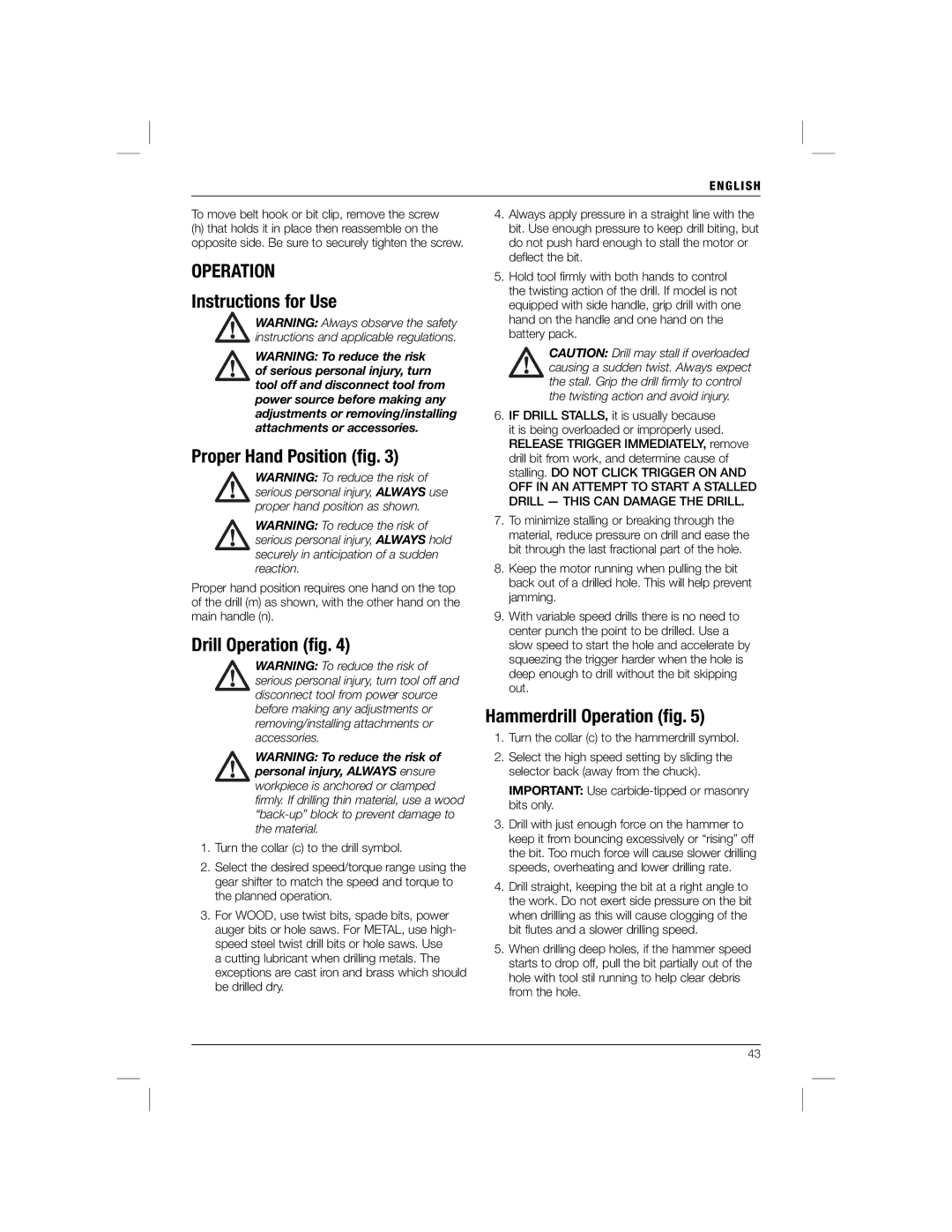
ENGLISH
To move belt hook or bit clip, remove the screw
(h)that holds it in place then reassemble on the opposite side. Be sure to securely tighten the screw.
OPERATION
Instructions for Use
WARNING: Always observe the safety instructions and applicable regulations.
WARNING: To reduce the risk of serious personal injury, turn tool off and disconnect tool from power source before making any adjustments or removing/installing attachments or accessories.
Proper Hand Position (fig. 3)
WARNING: To reduce the risk of serious personal injury, ALWAYS use proper hand position as shown.
WARNING: To reduce the risk of serious personal injury, ALWAYS hold securely in anticipation of a sudden reaction.
Proper hand position requires one hand on the top of the drill (m) as shown, with the other hand on the main handle (n).
Drill Operation (fig. 4)
WARNING: To reduce the risk of serious personal injury, turn tool off and disconnect tool from power source before making any adjustments or removing/installing attachments or accessories.
WARNING: To reduce the risk of personal injury, ALWAYS ensure workpiece is anchored or clamped firmly. If drilling thin material, use a wood
1.Turn the collar (c) to the drill symbol.
2.Select the desired speed/torque range using the gear shifter to match the speed and torque to the planned operation.
3.For WOOD, use twist bits, spade bits, power auger bits or hole saws. For METAL, use high- speed steel twist drill bits or hole saws. Use a cutting lubricant when drilling metals. The exceptions are cast iron and brass which should be drilled dry.
4.Always apply pressure in a straight line with the bit. Use enough pressure to keep drill biting, but do not push hard enough to stall the motor or deflect the bit.
5.Hold tool firmly with both hands to control the twisting action of the drill. If model is not equipped with side handle, grip drill with one hand on the handle and one hand on the battery pack.
CAUTION: Drill may stall if overloaded causing a sudden twist. Always expect the stall. Grip the drill firmly to control the twisting action and avoid injury.
6.IF DRILL STALLS, it is usually because it is being overloaded or improperly used. RELEASE TRIGGER IMMEDIATELY, remove drill bit from work, and determine cause of stalling. DO NOT CLICK TRIGGER ON AND OFF IN AN ATTEMPT TO START A STALLED DRILL — THIS CAN DAMAGE THE DRILL.
7.To minimize stalling or breaking through the material, reduce pressure on drill and ease the bit through the last fractional part of the hole.
8.Keep the motor running when pulling the bit back out of a drilled hole. This will help prevent jamming.
9.With variable speed drills there is no need to center punch the point to be drilled. Use a slow speed to start the hole and accelerate by squeezing the trigger harder when the hole is deep enough to drill without the bit skipping out.
Hammerdrill Operation (fig. 5)
1.Turn the collar (c) to the hammerdrill symbol.
2.Select the high speed setting by sliding the selector back (away from the chuck).
IMPORTANT: Use carbide-tipped or masonry bits only.
3.Drill with just enough force on the hammer to keep it from bouncing excessively or “rising” off the bit. Too much force will cause slower drilling speeds, overheating and lower drilling rate.
4.Drill straight, keeping the bit at a right angle to the work. Do not exert side pressure on the bit when drillling as this will cause clogging of the bit flutes and a slower drilling speed.
5.When drilling deep holes, if the hammer speed starts to drop off, pull the bit partially out of the hole with tool stil running to help clear debris from the hole.
43
